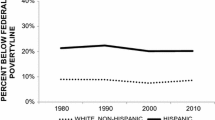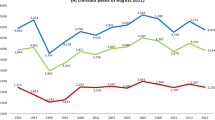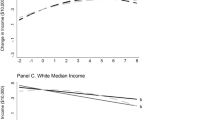Abstract
Traditional measures of poverty are informative in indicating the degree of economic deprivation in a population at a cross-sectional point in time, but they do not consider growth in the size of the non-poverty population. We develop a measure of non-poverty population growth in order to explore whether it constitutes a useful indicator of an important demographic dynamic. We illustrate our approach with an analysis of the U.S. states using Census and American Community Survey data from 1990, 2000, and 2010. The results indicate that the extent to which the non-poor population increased across states is uncorrelated with the initial poverty rate as conventionally measured. Broken down by nativity, the findings further show that some states with official poverty rates above the national average (e.g., Arizona, Georgia, and Texas) nonetheless had some of the highest rates of non-poor population growth among less skilled immigrants. By contrast, other states with official poverty rates below the national average (e.g., Connecticut, New Hampshire, and Vermont) often had low rates of non-poor population growth among less skilled immigrants. These findings suggest that low initial poverty rates do not necessarily contribute substantially to the alleviation of global poverty through the immigration of less skilled persons from less developed nations. However, the rate of non-poor population growth among less skilled immigrants also appears to be uncorrelated with state variation in minimum wages even after taking into account population density and median home value.



Similar content being viewed by others
Notes
In principle, poverty gap measures are theoretically attractive (e.g., Sen 1976), but in practice their validity requires far more reliable information on income than do headcount measures. We leave aside debates about the appropriate derivation of the poverty threshold or the proper measurement of income (Iceland 2006) because our approach is flexible in regard to those methodological issues.
Populations outside of the census poverty universe include individuals living in institutions, military quarters and college dormitories, as well as unrelated individuals under 15 years of age.
References
Bane, M. J. (2009). Poverty politics and policy. In M. Cancian & S. Danziger (Eds.), Changing poverty, changing policies (pp. 367–386). New York: Russell Sage Foundation.
Bishaw, A., & Iceland, J. (2003). Poverty: 1999 (Census 2000 Brief C2KBR-19). Washington, DC: U.S. Census Bureau. http://www.census.gov/hhes/www/poverty/publications/c2kbr-19.pdf.
Block, W., & Barnett, W. (2008). The living wage: What’s wrong? In W. Block (Ed.), Labor economics from a free market perspective: Employing the unemployable (pp. 157–158). Hackensack, NJ: World Scientific Publishing.
Brown, S. K., & Bean, F. D. (2006). International migration. In D. L. Poston & M. Micklin (Eds.), Handbook of population (pp. 347–382). New York: Springer.
Cypher, J. M., & Dietz, J. L. (2008). The process of economic development (3rd ed.). New York: Taylor & Francis.
Iceland, J. (2006). Poverty in America: A handbook. Berkeley, CA: University of California Press.
Kirk, D. (1996). Demographic transition theory. Population Studies, 50(3), 361–387.
Malthus, T. R. (2000[1798]). An essay on the principle of population. London, UK: Printed for J. Johnson in St. Paul’s Church Yard.
Massey, D. S., Arango, J., Hugo, G., Kouaouci, A., Pellegrino, A., & Taylor, J. E. (1993). Theories of international migration: A review and appraisal. Population and Development Review, 19(3), 431–466.
Meyer, D. R., & Wallace, G. L. (2009). Poverty levels and trends in comparative perspective. In M. Cancian & S. Danziger (Eds.), Changing poverty, changing policies (pp. 35–62). New York: Russell Sage Foundation.
Rawls, J. (1971). A theory of justice. Cambridge, MA: Harvard University Press.
Sen, A. (1976). Poverty: An ordinal approach to measurement. Econometrica, 44, 219–231.
U.S. Census Bureau. (2003). Census 2000, Public Use Microdata Sample: Technical Documentation. Washington, DC.
U.S. Census Bureau. (2009). Design and methodology: American community survey. Washington, DC.
U.S. Census Bureau. (2012a). Resident population data: Population density. Accessed May 10. http://2010.census.gov/2010census/data/apportionment-dens-text.php.
U.S. Census Bureau. (2012b). Historical census of housing tables: Home values. Accessed May 10. http://www.census.gov/hhes/www/housing/census/historic/values.html.
U.S. Department of Labor. (2012). Changes in basic minimum wages in non-farm employment under State LAW: Selected years 1968 to 2012. Accessed May 10. http://www.dol.gov/whd/state/stateMinWageHis.htm.
Acknowledgments
The authors would like to thank one anonymous reviewer for her comments although any remaining errors are our own. Both authors contributed equally to this work.
Author information
Authors and Affiliations
Corresponding author
Rights and permissions
About this article
Cite this article
Sasson, I., Sakamoto, A. Non-poor Components of Population Growth and Immigration in the U.S., 1990–2010. Soc Indic Res 115, 183–201 (2014). https://doi.org/10.1007/s11205-012-0214-6
Accepted:
Published:
Issue Date:
DOI: https://doi.org/10.1007/s11205-012-0214-6




